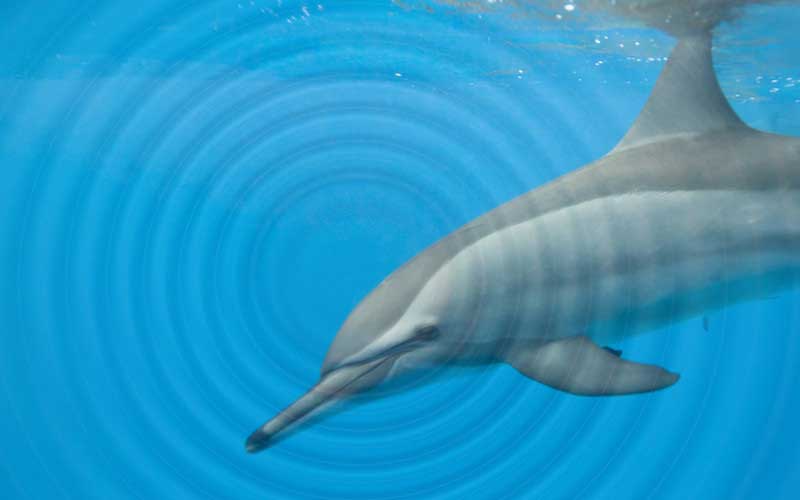THE FOUNDATION OF COMMUNICATION
Dolphins have the ability to communicate with each other, and for that purpose, they use sounds and body movements. Scientists have been very interested in the way they produce sounds, and the studies they have carried out show that dolphins are animals with a diversity of sounds and a complex language.
Sound waves travel nearly 4.5 times faster in the aquatic environment than in the air. The sounds are essential in the life of any dolphin and in general, of any cetacean. Dolphins communicate, hunt, avoid predators and orient themselves when navigating through sound emissions in the water, therefore, they are very sensitive animals to noises emitted in and out of the water.
Not all sounds are the same. They vary in frequency, volume, wavelength and pattern and depend on the intention or the situation in which the dolphins are. If they are scared, excited or in a context of socialization, they tend to make whistles, but if they are in trouble, they make clicks with their jaws. In general, they communicate using low-frequency sounds but emit other high-frequency signals when using echolocation.
Most people have heard the chirping, squeaking noises made by dolphins which they use to communicate with other dolphins or for echolocation. Dolphins can use echolocation to detect even a three-inch object as far as the length of a football field.
Sounds are essential in the life of any dolphin and in general, of any cetacean.
TYPES OF SOUNDS
Within the range of sounds that dolphins produce are whistles, squeaks, crunches, clicks and some similar to screams. From a general perspective, the sounds can be burst-pulsed or frequency modulated. Sometimes a separation of a burst of clicks to the previous ones is made when used for echolocation and not precisely for communication between the members of a pod.
Dolphins produce frequency modulated sounds by changing the tone while emitting them, that is, it can go up or down. Pure whistles, squeaks, and squeals are frequency modulated sound. Bottlenose dolphins have a “signature whistle,” well differentiated from other sounds, which identifies a particular dolphin from the others.
On the contrary, the burst-pulsed sounds are brief, emitted successively and at regular intervals. In this category are clicks and bursts produced when the cetacean emits clicks remarkably fast.
DOLPHIN COMMUNICATION PROCESS
Dolphins produce sounds from the vibrations of an air sac in their respiratory cavities. They lack vocal cords, so they are unable to make emissions with them.
Production and emission.
When the air enters through the blowhole the nasal air sacs swell and Some structures of the nasal passages, called phonic lips, open and close continuously, making vibrate the surrounding tissues, generating sound waves.
The waves group in bundles in the melon and the dolphin directs them forward. Then the sound waves bounce back when they find objects in their path.
Reception.
Part of the signal bounces back and returns to the dolphin as an echo. It may seem strange, but the bones of the lower jaw are the principal areas of reception of sounds. From there they travel to the inner ear and then to the auditory centers of the brain.
Interpretation.
The brain receives the returned sound waves in the form of nerve impulses, and the dolphin can interpret the echo.
One of the primary uses of sounds by dolphins is for echolocation, which is an ability of Odontoceti cetaceans, based on the emission of sounds and the interpretation of their echo.
DO DOLPHINS HAVE LANGUAGE?
Whether or not dolphins have language is a matter for debate unless and until we humans figure out how to speak to them. But evidence is mounting that dolphins may indeed have a language.
There is a lot of research on dolphin vocabulary that indicates they communicate with at least as much sophistication as the higher apes. They have a lexicon of danger sounds, food sounds, seeking sounds, and sometimes they put these sounds together in a reasonably sophisticated fashion. There is evidence that they may greet one another by name because they utter unique sounds when meeting other dolphins.
DOLPHINS AND MAN-MADE SONAR
Dolphins are incredibly good at distinguishing their echolocation sounds even in very noisy underwater environments. It has also been found, though, that some noisy locations confuse dolphins.
Beaching is probably the most tragic thing that we can see: a pod of dolphins that have apparently killed themselves by swimming onto a beach and lodging themselves there.
Why do dolphins do this? The most accepted theory is that something confuses their echolocation, taking them to the beach instead of the open ocean. Some autopsies of beached dolphin bodies show a very high percentage of damaged hearing, suggesting that a powerful sound may have blown out their hearing.
Although dolphins see quite well, without their hearing sense, they are disoriented and blinded. And when one dolphin beaches itself, the others are at risk because they will try to help it.
References
https://dolphins.org/acoustics
http://biol.wwu.edu/mbel/media/pdfs/AquatMamm2004_30.pdf
https://www.uaeh.edu.mx/scige/boletin/prepa3/n1/r2.html
Janik, Vincent; Laela Sayigh (7 May 2013). “Communication in bottlenose dolphins: 50 years of signature whistle research”. Journal of Comparative Physiology.
Dolphin Mysteries: Unlocking the Secrets of Communication. Yale University Press. 2008.
Denise L. Herzing. Dolphin Communication and Cognition: Past, Present, and Future. MIT Press, 2015.

